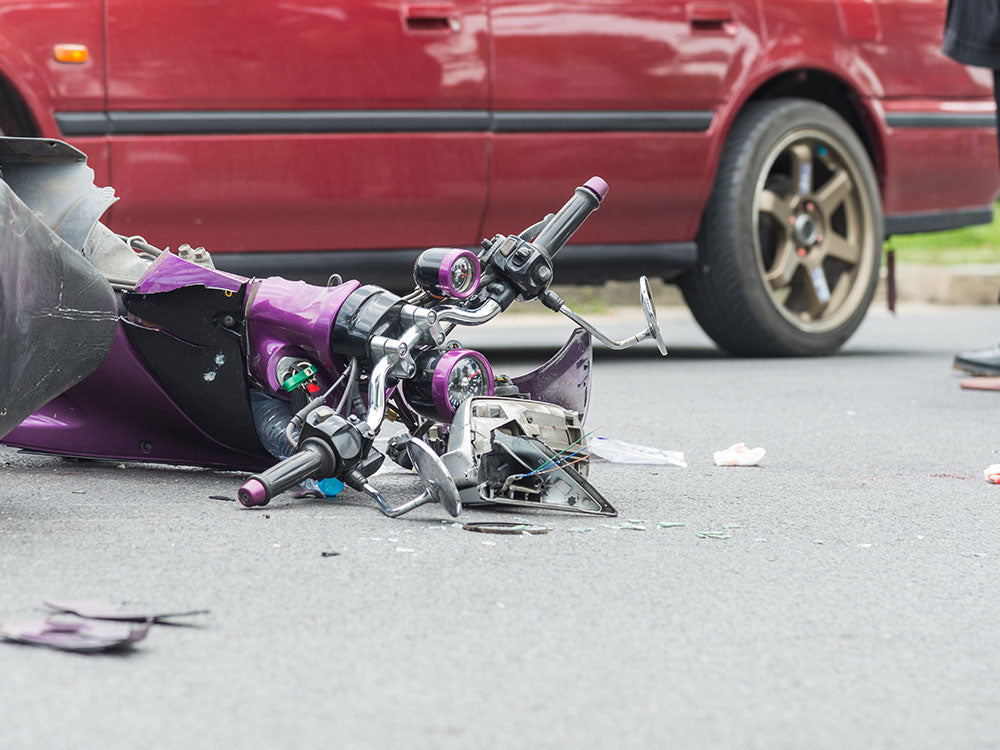Table of Content
| State | Year | Fatalities Number | Fatalities Percent |
|---|---|---|---|
| Alaska | 2020 | 4 | 8.2% |
| Alabama | 2020 | 78 | 9.5% |
| Mississippi | 2020 | 62 | 9.7% |
| Kentucky | 2020 | 92 | 13.5% |
| Virginia | 2020 | 101 | 13.9% |
| Missouri | 2020 | 123 | 14.5% |
| Nebraska | 2020 | 34 | 15.5% |
| Wyoming | 2020 | 19 | 15.8% |
| North Dakota | 2020 | 17 | 18.7% |
| Vermont | 2020 | 10 | 18.9% |
In the United States, there is always a higher chance of accidents and fatalities when it comes to motorcycles. This article discusses the U.S. states with the fewest motorcycle fatalities according to the National Highway Traffic Safety Administration (NHTSA).
1. Top 10 States With Fewest Motorcycle Fatalities in 2020
1.1 Alaska
| State | Year | Number of Fatalities | Percentage of Fatalities |
|---|---|---|---|
| Alaska | 2020 | 4 | 8.2% |
Alaska had the fewest number of motorcycle fatalities in 2020. However, looking at the statistics of previous years, Alaska had higher motorcycle fatalities. From 2018 to 2019, Alaska saw more motorcycle fatalities than in any other consecutive two-year period since 2015. In 2018, 12 fatal motorcycle accidents occurred, which represented 15% of all motor vehicle fatalities. However, the number of fatalities fell in 2019 and continued to drop in 2020.
1.2 Alabama
| State | Year | Number of Fatalities | Percentage of Fatalities |
|---|---|---|---|
| Alabama | 2020 | 78 | 9.5% |
Alabama only accounts for 9.5% of total traffic fatalities. Despite the fact that Alabama is listed as the tenth state with the worst roads in the U.S., the strict motorcycle helmet law has saved the lives of many riders for nearly 44 years.
1.3 Mississippi
| State | Year | Number of Fatalities | Percentage of Fatalities |
|---|---|---|---|
| Mississippi | 2020 | 62 | 9.7% |
Mississippi has enforced a strict motorcycle helmet law since 1974. Mississippi motorcycle fatalities only made up 9.7% of all traffic fatalities throughout the United States.
1.4 Kentucky
| State | Year | Number of Fatalities | Percentage of Fatalities |
|---|---|---|---|
| Kentucky | 2020 | 92 | 13.5% |
Kentucky only accounts for 13.5 % of all traffic fatalities throughout the United States in 2020.
In 1968, Kentucky adopted a motorcycle helmet law that was later repealed in 1998 for riders older than the age of 21 who had held their licenses for more than a year and could provide proof of insurance. In 2000, Kentucky removed the requirement for owning health insurance entirely.
In Kentucky, you can ride without a helmet if you meet the criteria. However, this lax in motorcycle helmet law has resulted in slightly more fatalities in recent years.
1.5 Virginia
| State | Year | Number of Fatalities | Percentage of Fatalities |
|---|---|---|---|
| Virginia | 2020 | 101 | 13.9% |
Virginia only had 101 motorcycle fatalities and accounted for only 13.9% of all traffic fatalities in 2020. Like Vermont, the state has had a helmet requirement in place since 1970 with no changes.
1.6 Missouri
| State | Year | Number of Fatalities | Percentage of Fatalities |
|---|---|---|---|
| Missouri | 2020 | 123 | 14.5% |
Missouri accounts for only 14% of total traffic deaths throughout the U.S in 2020. Missouri has enforced a motorcycle helmet law since 1967 and requires all riders and passengers to wear a helmet.
Missouri no longer requires all motorcycle riders to wear helmets as of 2020; instead, it now only applies to those who are under 25. You are not required by law to drive with a helmet on if you are over 26 and have health insurance.
1.7 Nebraska
| State | Year | Number of Fatalities | Percentage of Fatalities |
|---|---|---|---|
| Nebraska | 2020 | 34 | 15.5% |
During 2020, Nebraska accounted for 15.5% of all traffic fatalities throughout the United States. Nebraska implemented a mandatory helmet regulation in 1967. Although it was officially repealed in 1977, the NHTSA continues to enforce the motorcycle helmet law.
The prevalent belief that helmet laws save lives is, however, contradicted by the fact that there are only 38 motorcyclist fatalities in a state without helmet legislation yearly.
1.8 Wyoming
| State | Year | Number of Fatalities | Percentage of Fatalities |
|---|---|---|---|
| Wyoming | 2020 | 19 | 15.8% |
In 2020, Wyoming accounted for over 15% of total traffic fatalities throughout the United States. Wyoming’s low population and clear sight lines contribute to the low statistics.
In 2009, Wyoming was the state with the 11th lowest number of fatal motorcycle accidents.
Wyoming’s motorcycle helmet law has been changed twice since its implementation in 1973; first, repealing the requirement for riders ages 19 or above and then no longer requiring riders ages 18 or above to wear motorcycle helmets.
1.9 North Dakota
| State | Year | Number of Fatalities | Percentage of Fatalities |
|---|---|---|---|
| North Dakota | 2020 | 17 | 18.7% |
North Dakota has a consistent track record of safe riding conditions and few motorcycle fatalities.
North Dakota's roads were praised as being some of the best in the country due to their low traffic and the excellent quality of the roads.
1.10 Vermont
| State | Year | Number of Fatalities | Percentage of Fatalities |
|---|---|---|---|
| Vermont | 2020 | 10 | 18.9 |
Vermont owes its low motorcycle fatality rate to the fact that there is a narrow window for motorcycle riders to get on the road due to the long winter. Perhaps this contributes significantly to Vermont's ranking as one of the safest states for motorcyclists. The state might end up at the other end of the equation if snowmobiles were added to the equation.
Another factor that contributes to Vermont’s low fatality rate is its mandatory helmet law established in 1968.
2. Why is the Chance of Motorcycle Fatalities in Accidents so High?
There is a high probability of motorcycle fatalities during accidents for the following reasons:
- Blind Spots: Motorcycles traveling beside another car may not be visible in the blind spots, resulting in a collision when the car is changing lanes. When changing lanes, drivers who neglect to look over their shoulders run the risk of colliding with a motorcycle in their blind zone.
- Lack of Protective Measures: Compared to motorcycles, four-wheelers offer better protection for the occupants. Passengers in cars are less likely to be thrown from the vehicle due to seat belts and airbags. Although motorcyclists may wear helmets, this does not guarantee you will not suffer a fatal injury when thrown from the bike and colliding with another car, a tree, etc.
- Excessive Speed: More than 30% of fatal motorcycle accidents are caused by excessive speed.
- Distracted Driving: Distracted drivers fail to pay attention to oncoming traffic, traffic signals, and changing traffic conditions. Despite greater public awareness and stricter restrictions, the usage of cell phones while driving has often led to collisions.
3. How to Reduce the Risk of Motorcycle Fatalities
- Wear a Helmet: One of the most effective ways to reduce the risk of fatal injuries resulting from motorcycle accidents is to wear a helmet. Motorcycle helmets protect the motorcyclist's head in the event of an impact. They lower the risk of death by 42% and the chance of head injury by 69%.
-
Wear Proper Protective Gear:Make sure to wear protective gear to reduce scraping and impact if thrown from the motorcycle. Protective motorcycle gear includes
- Eye protection
- Long-sleeved leather jacket
- Full-length pants
- Boots
- Gloves
You should also have saddlebags, fairings, crash bars, and suitable handlebars.
- Go Slow: The slower you go, the more time you have to spot and react to incoming dangers.
- Take Motorcycle Safety Riding Course: To become a skilled motorcyclist, it is recommended you take a motorcycle safety riding course. You will learn about traffic laws, proper riding skills in controlled environments, and defensive riding habits.
4. Last Words
In the United States, most traffic fatalities are due to motorcycle crashes. Motorcycle fatality rates in different states vary due to strict helmet laws or the passage of time. The U.S. states discussed above may have high motorcycle fatalities in the future, but they had the fewest motorcycle fatalities in 2020.













Leave a comment
All comments are moderated before being published.
This site is protected by hCaptcha and the hCaptcha Privacy Policy and Terms of Service apply.